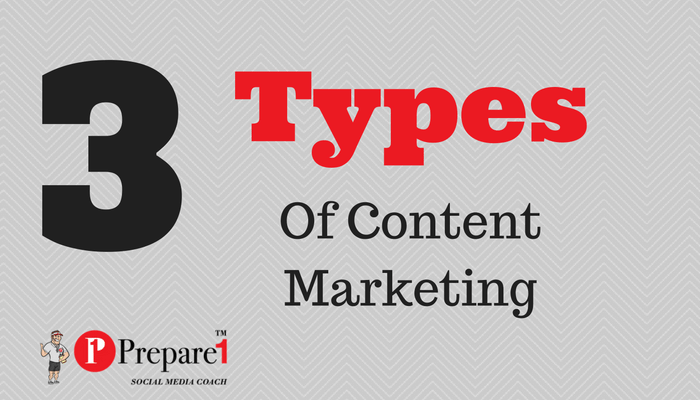
How much content have you produced in the last week? Last Month?
Are you pleased with your consistency and results?
If you’re not “all in” with your content marketing program, you should stop.
Or as Yoda told Luke Skywalker, “Do or do not, there is no try.” Be all in or get all out. There is no halfway.
It requires you to be fully committed to your content marketing program — something that only 20% of marketers say they are, according to CMI research to be released later this month.
To be clear: “Go all in” is not synonymous with “do everything.” You need to slow down and do your content marketing right — or don’t do it at all.”
WHAT IS CONTENT MARKETING?
It is a strategy of producing and publishing information that builds trust and authority among your ideal customers.
- It is a way to build relationships and community, so people feel loyal to you and your brand.
- It is a strategy for becoming recognized as a thought leader in your industry.
- It is a way to drive sales without traditional “hard sell” tactics.
TOP CHALLENGES
56% say producing engaging content is the #1 Challenge.
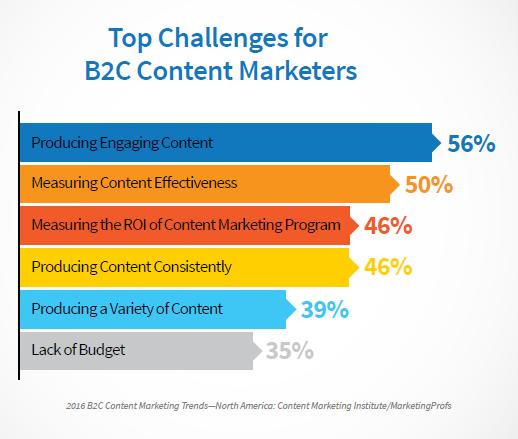
• Understanding/choosing technology that we need (31%)
• Implementing the technology that we already have in place (24%)
• Lack of buy-in/vision from higher-ups (23%)
• Lack of integration across marketing (22%)
• Gaps in knowledge and skills of internal team (21%)
• Finding or training skilled content marketing professionals/content creators (18%)
• Other (6%)
• No challenges (1%)
B2C marketers’ challenges are similar to those faced by B2B marketers; however, B2C marketers are more challenged with understanding/choosing technology (31% B2C vs. 24% B2B) and implementing the technology they currently have in place (24% B2C vs. 18% B2B).
Easier Way to Produce Content
Believe me, I get it. Creating a high amount of high quality content on a regular basis is hard.
But the traffic, subscribers, and eventual sales you get from it make creating content a necessity for most businesses.
There are a few ways to make it easier to produce whatever level of content you’re trying to:
- Raise your budget (hire writers)
- Devote more time to it
- Write faster
The first two are often out of your control or not possible at this time. The third one, however, is almost always possible.
How to Write Faster
You can make this faster with tools: If you adopt this process, it should bring down your writing time by a bit and make it more fun.
However, if you’re really looking to minimize your writing time, a few tools can greatly speed up your writing time further.
First, consider hiring a virtual assistant (transcriptionist) to type up your narrations. Once you train them, it will save you a considerable amount of time for a small cost.
Next, you could also use more advanced narration tools to record your thoughts directly in a Word document.
Recently, Google Docs added a new feature for voice typing. Go to “Tools > Voice typing…” to enable it.

Next, click on the microphone icon that pops up. Once you do, it should turn orange to indicate that it’s listening.

From there, you can just speak, and the tool does a pretty amazing job at capturing your words. It’s not perfect, of course, but the technology has come a long way. It’s free, compared to the top of the line Dragon Speech Software running into the hundreds to purchase.
Give it a try!
SET TIME LIMITS
Some of you will remember the days without the internet. Oh…and Email! Right? I remember the day I got my first email and was like WOW! Now, not so much.
Here’s my point. We live in a fast paced world where things are going to get faster not slower. We have more to do in our daily lives, yet we must produce results.
So the question becomes how?
We have to be very focused on our goals and objectives, yet remain flexible in how we get there.
According to Parkinson’s law,
- Work expands so as to fill the time available for its completion.
Even if you haven’t heard of it, I bet you’ve noticed it before.
How productive were you when you knew you were going on vacation? You were days if not hours away, you made a list, you prioritized and you got it done in record time. Why?
FOCUSED
CONTENT PLAN
What type of content do you want to produce?
A particular theme each day? Week?
DECIDE HOW YOU’LL USE CONTENT MARKETING
TO GROW YOUR BUSINESS
There’s no right answer here. Just pick one. From a high level perspective, what do you want to do? For example:
- Prospecting. Generate leads for follow-up by sales and marketing teams.
- Sales. Help your sales team close sales more quickly.
- Marketing. Generate interest in your products.
- PR. Build and repair public opinion about your brand and products.
- Community. Develop friends and fans who interact with your brand socially.
- Customer support. Help customers get the most from your products.
- Thought leadership. Develop name recognition and respect, and to influence your industry.
DECIDE WHO YOU WANT TO READ YOUR CONTENT
-
SELECT THE NICHE.
The truth about marketing is that if you target everyone, you’ll hit no one. So you need to define the niche that you want to serve. This is a specific group of people who are interested in the topic you write about.
-
REFINE THE NICHE.
to be specific about who you write for. For example, “Animal lovers” is a niche, but it’s relatively broad. “Dog lovers” is a more targeted niche and could make a better target.
-
CAN YOU NARROW THE FIELD EVEN MORE?
A micro-niche is a subset of your chosen niche. For example, “dog breeders” or “lovers of hairless dogs” are micro-niches in the “dog lovers” niche.
When picking your target audience, choose as small a group as possible that is large enough to help you meet your marketing objectives.
TYPES OF CONTENT
1. How-to
- The how-to is one of the most popular types of content, especially in my niche. On my blog, I write a lot of how-to guides. How-to articles have awesome long tail search potential due to these popular long tail query introductions: “How to…” and “How do I…?”
How to do it
First, identify a common problem. Then, come up with a solution. The model is simple:
- Introduce the problem
- Introduce the solution
- Discuss each step of the solution
- Summarize the discussion
- Provide a conclusion
Things to keep in mind
- The options for how-tos are inexhaustible. Think of one topic that reflects something you do on a daily basis. Next, write a how-to article based on that one issue. It could be industry specific or more general: “How to reply to every email in one minute or less.”
- The more thorough your explanation is, the better. Diagrams, videos, and pictures can all help enhance the how-to blog.
2. Infographics
An infographic is the presentation of information or data in a visual way. Its name sums it up —info + graphic.
Infographics get shared more, viewed more, and loved more than most other content types. They are a powerful way to get your information out there in an explosively visual format. One study found that infographics were liked and shared on social media up to three times more often than other content. The viral potential is there.
How to do it
If you have a graphic designer in your professional network, tap him or her to make an infographic for you. Some graphic artists specialize in infographics. If you have it in your budget, you can use a service like Visual.ly. Infographics typically start at $1,000.
When to use it
Infographics are perfect for communicating almost any idea or concept. Data, research, statistics, and findings work especially well.
Things to keep in mind
- Infographics can be expensive. The amount cited above — a thousand dollars — is pretty close to the standard price.
- Infographics used to go viral just by virtue of being an infographic. That doesn’t work anymore. Everyone is making infographics. Today, you have to make it really good to make it shareable.
- Make a gifographic. Gifographics use the infographic model but feature animated gifs instead of the static images of a conventional infographic.
3. Videos
There’s a world of variety within videos. I could write a whole separate post on different types of videos. No matter what type it is, however, a good video communicates a message in a succinct and memorable way. Done well, a video can be extraordinarily persuasive.
How to do it
- Whether you create a video of an office tour, an explainer video, or a music video (it’s been done), you’ve got to get the script right. A video isn’t only about the moving picture; it’s about the words that you say or display. Check out a few more tips for making an explainer video.
- Put the video on YouTube and Vimeo. Both of these video sharing sites are great ways to garner social signals for SEO and improved results for video search itself.
Things to keep in mind
- Making a good video is not cheap. You can start small, of course, but contracting a video specialist or a camera crew can cost quite a bit.
- Videos aren’t supposed to be long. Two to three minutes is a good length.
Meme
You’ve seen memes in social media. They’re easy to make. They’re viral. They’re funny.

That’s one of the great benefits of memes — their humor. People love something that they can laugh at, share, and get a kick out of.
How to do it
- Memes don’t require graphic design skills. Meme Generator and Quick Meme are sites that allow you to add your own text to popular meme images.
- Memes may not be the best type of content to share on your blog, but they’re primed for social media outlets. Twitter, Stumbleupon, Pinterest, Reddit, and Tumblr (especially Tumblr) will help your meme to spread.
- Memes are just-because content. When the mood hits or a funny idea strikes you, go ahead and meme it.
Things to keep in mind
- They are adaptable. The great thing about memes is that they can be adapted for use in any niche. Your niche is neither too narrow nor abstruse to warrant its own meme.
- Memes can be low value, so don’t overuse them. When misused, they can devalue the message or brand that you’re trying to promote.
FINAL THOUGHTS
There are plenty of content options available to you than the three I shared with you above. The key is to START, TAKE ACTION.
Let your creativity go.
Make a commitment to yourself and to your career or business.
The more types of content you use, the more powerful your content marketing efforts become. Content, regardless of its form, speaks to an audience.
That audience in turn…
- Listens
- Comments
- Shares
- Likes
- Learns
- and Converts
There’s a wealth of potential here — the kind of potential that your brand needs in order to advance to the next level. Now, you have a plan to get there. Time to lace up the Nike’s and start running.
Is there a particular type of content you prefer and why?
Source: Quicksprout
About Blair

Blair Evan Ball is a Social Media Coach and founder of Prepare1, a company that works with businesses, individuals and non-profits. He is a former executive with a Fortune 50 company, and his national division did $1Billion+ in sales annually.
Blair has written three e-books: Facebook for Business Made Easy, Facebook Pages for Business Made Easy, and WordPress Blog Setup Made Easy.
Blair also educates, trains entrepreneurs and business professionals how to amplify their brand, increase revenues, and raise more funds.
![[Study] How Will Businesses Change Their Social Media Activities 5 Golden Rules for Sharing on Social Media](https://www.prepare1.com/wp-content/uploads/2014/03/COACH-logohat-162x300.jpg) The Race is ON! | PREPARE | Get into the Game and WIN!
The Race is ON! | PREPARE | Get into the Game and WIN!

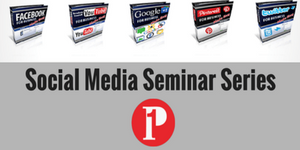



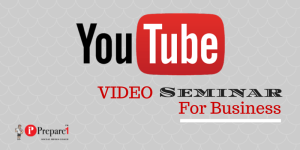
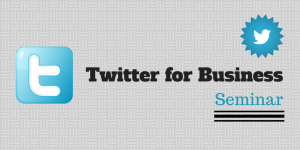




Comments on this entry are closed.
{ 1 trackback }